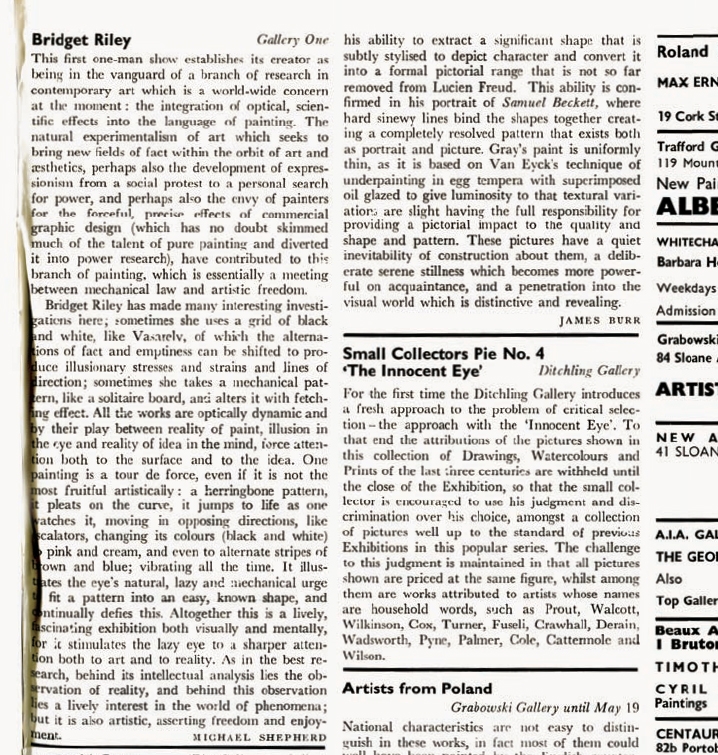Supported by her extensive body of writing, Bridget Riley’s art and continuous research has been – and still is – a major influence for generations of artists, reaching beyond the realm of paintings. To mark its own 65th anniversary, and to coincide with a show of Bridget Riley’s Stripe paintings at David Zwirner, London, ArtReview has delved into the archives to retrace Riley’s career, through a selection of reviews and interviews published in the magazine between 1962 – the year of her first solo show – and 2010. The first was written by Michael Shepherd, about her exhibition at Gallery One.
Bridget Riley
Gallery One
This first one-man show establishes its creator as being in the vanguard of a branch of research in contemporary art which is a world-wide concern at the moment: the integration of optical, scientific effects into the language of painting. The natural experimentalism of art which seeks to bring new fields of fact within the orbit of art and aesthetics, perhaps also the development of expressionism from a social protest to a personal search for power, and perhaps also the envy of painters for the forceful, precise effects of commercial graphic design (which has no doubt skimmed much of the talent of pure painting and diverted it into power research), have contributed to this branch of painting, which is essentially a meeting between mechanical law and artistic freedom.
Bridget Riley has made many interesting investigations here; sometimes she used a grid of black and white, like Vasarely, of which the alternations of fact and emptiness can be shifted to produce illusionary stresses and strains and lines of direction; sometimes she takes a mechanical pattern, like a solitaire board, and alters it with fetching effect. All the works are optically dynamic and by their play between reality of paint, illusion in the eye and reality of idea in the mind, force attention both to the surface and to the idea. One painting is a tour de force, even if it is not the most fruitful artistically: a herringbone pattern, it pleats on the curve, it jumps to life as one watches it, moving in opposing directions, like escalators changing its colours (black and white) to pink and cream, and even to alternate stripes of brown and blue; vibrating all the time. It illustrates the eye’s natural, lazy and mechanical urge to fit a pattern into an easy, known shape, and continually defies this. Altogether this is a lively, fascinating exhibition both visually and mentally, for it stimulates the lazy eye to a sharper attention both to art and to reality. As in the best research, behind its intellectual analysis lies the observation of reality, and behind this observation lies a lively interest in the world of phenomena; but it is also artistic, asserting freedom and enjoyment.
Michael Shepherd, 1962
This article was first published in the Summer 2014 issue as part of the feature The ArtReview files: Bridget Riley
Bridget Riley: The Stripe Paintings 1961–2014, 13 June through 25 July 2014 at David Zwirner, London
